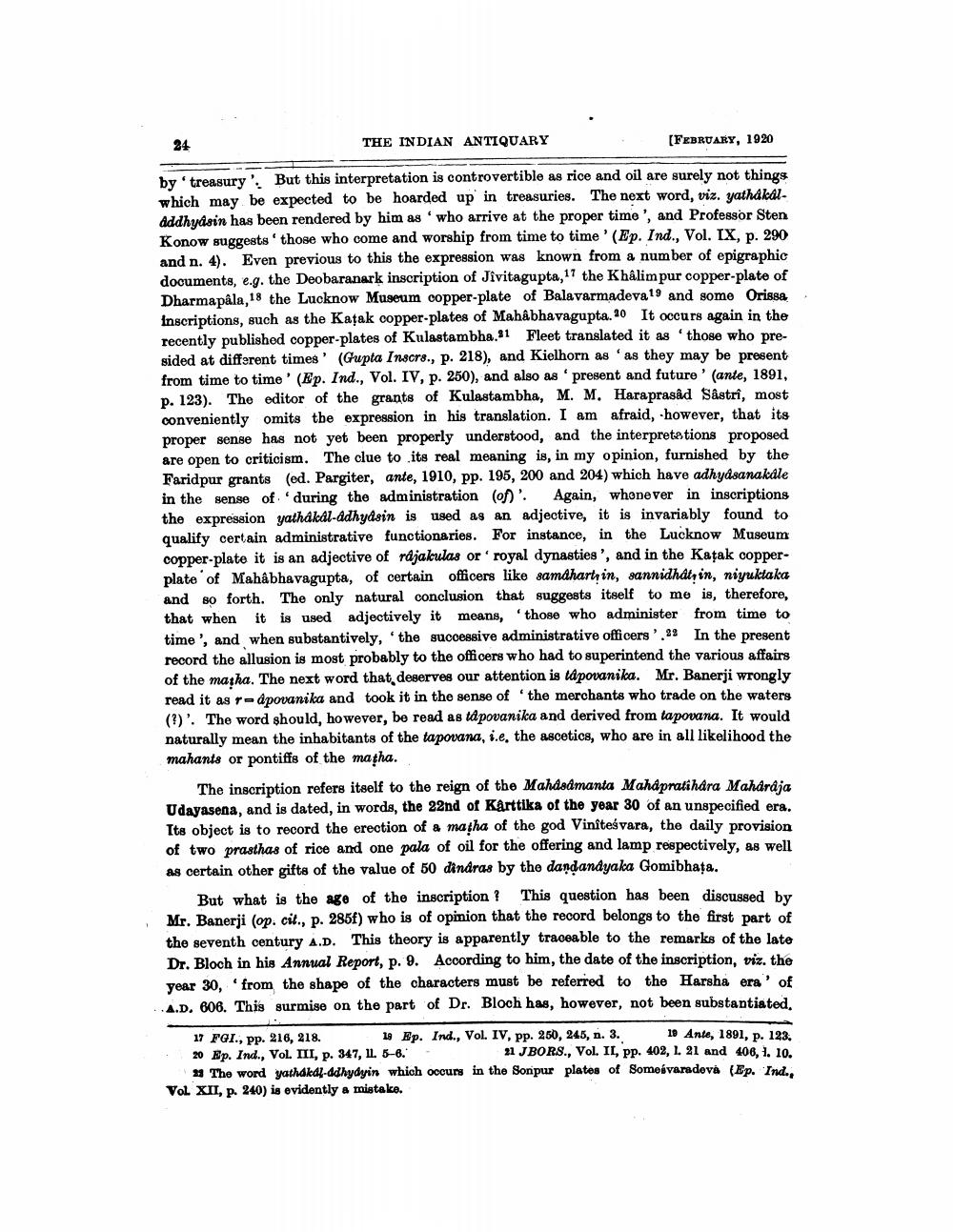________________
24
THE INDIAN ANTIQUARY
[FEBRUARY, 1920
.
by treasury'. But this interpretation is controvertible as rice and oil are surely not things which may be expected to be hoarded up in treasuries. The next word, viz. yathakal Addhyásin has been rendered by him as 'who arrive at the proper time', and Professor Sten Konow suggests' those who come and worship from time to time' (Ep. Ind., Vol. IX, p. 290 and n. 4). Even previous to this the expression was known from a number of epigraphic documents, e.g. the Deobaranark inscription of Jivitagupta, 17 the Khâlim pur copper-plate of Dharmapala, 18 the Lucknow Museum oopper-plate of Balavarmadeva 19 and some Orissa Inscriptions, such as the Kațak copper-plates of Mahâbhavagupta. 20 It occurs again in the recently published copper-plates of Kulastambha.81 Fleet translated it as 'those who presided at different times' (Gupta Inscrs., p. 218), and Kielhorn as 'as they may be present from time to time' (Ep. Ind., Vol. IV, p. 250), and also as present and future' (ante, 1891, p. 123). The editor of the grants of Kulastambha, M. M. Haraprasad Sastri, most conveniently omits the expression in his translation. I am afraid, however, that its proper sense has not yet been properly understood, and the interpretations proposed are open to criticism. The clue to its real meaning is, in my opinion, furnished by the Faridpur grants (ed. Pargiter, ante, 1910, pp. 195, 200 and 204) which have adhyasanakale in the sense of during the administration (op'. Again, whonever in inscriptions the expression yathakal-Adhydsin is used as an adjective, it is invariably found to qualify certain administrative functionaries. For instance, in the Lucknow Museum copper-plate it is an adjective of rajakulas or royal dynasties', and in the Katak copperplate of Mahâbhavagupta, of certain officers like samdhartin, sannidhat, in, niyuktaka and so forth. The only natural conclusion that suggests itself to me is, therefore, that when it is used adjectively it means, those who administer from time to time', and when substantively, the successive administrative officers' 28 In the present record the allusion is most probably to the officers who had to superintend the various affairs of the majha. The next word that deserves our attention is tápovanika. Mr. Banerji wrongly read it as - Apovanika and took it in the sense of the merchants who trade on the waters (?)'. The word should, however, be read as tá povanika and derived from tapovana. It would naturally mean the inhabitants of the tapovana, ie, the ascetics, who are in all likelihood the mahants or pontiffs of the magha.
The inscription refers itself to the reign of the Mahdadmanta Mahapralihara Mahardja Udayasena, and is dated, in words, the 22nd of Kårttika of the year 80 of an unspecified era. Its object is to record the erection of a matha of the god Viniteśvara, the daily provision of two prasthas of rice and one pala of oil for the offering and lamp respectively, as well as certain other gifts of the value of 50 dindras by the dandandyaka Gomibhata.
But what is the age of the inscription? This question has been discussed by Mr. Banerji (op. cit., p. 285f) who is of opinion that the record belongs to the first part of the seventh century A.D. This theory is apparently traceable to the remarks of the late Dr. Bloch in his Annual Report, p. 9. According to him, the date of the inscription, viz. the year 30, from the shape of the characters must be referred to the Harsha era of A.D. 106. This gurmise on the part of Dr. Bloch has, however, not been substantiated.
17 FGI., pp. 216, 218. 19 Ep. Ind., Vol. IV, pp. 260, 245, n. 3. 19 Ante, 1891, p. 123. 20 Ep. Ind., Vol. III, p. 347, 11. 5-6.
21 JBORS., Vol. II, pp. 402, l. 21 and 406, 1. 10. The word yathakdf-adhydyin which occurs in the Sonpur plates of Someivaradova (Ep. Ind. VOL XII, p. 240) is evidently a mistake.




